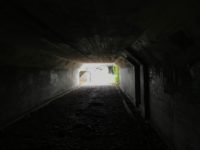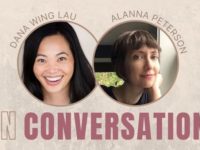As you might have guessed if you’ve read When We Vanished, I am a total science nerd. My bachelor’s degree was in molecular biology with a minor in chemistry, and I completed my master’s in nutrition in a research-focused program. Plus, I currently work in the research world.
So when I decided to write a novel where science played into the plot, I didn’t want to revert to standard tropes, with a mad scientist cackling in a darkly-lit lab surrounded by Erlenmeyer flasks full of bubbling fluorescent liquids. Fun as that may be, it was important to me that the science felt real.
Designing a Fictional Feeding Study
For a brief time during grad school, I worked in a metabolic kitchen. The studies we conducted provided all the participants’ meals and snacks. Participants were also asked not to eat non-study food for the duration of the feeding period. (We were pretty forgiving of the occasional slip-up, though, since we knew this was a lot to ask.)
The project I designed for my novel goes one step further, not only providing study food but requiring participants to live at the research facility. This is admittedly unusual, but not outside the realm of possibility.
Years ago, I attended a cancer prevention research practicum organized by the National Cancer Institute. It included a tour of the USDA facility in Beltsville, MD, which contained several room calorimeters. Participants would live for days or weeks in these small rooms while their energy expenditure was being meticulously measured.
I couldn’t help wondering what that would be like from the participant’s point of view. Even though I had no intention of writing novels back then, this tour apparently made quite the lasting impression on me!
Creating the Creepy Atmosphere at SILO
Have you ever heard the adage, “write what scares you?” Apparently this is something I’ve taken to heart, because writing fiction has become my way of facing things that terrify me. These can be big things, of course, but smaller scary stuff gets a spotlight as well. Some of these things became key components of the sinister ambience at SILO, the secretive research facility featured in When We Vanished.

Incubator Rooms
Take, for example, incubator rooms. When I worked in a microbiology lab, I was always grateful that I worked on plant pathogens that grew at room temperature. I could just leave my test tubes and petri dishes on my lab bench and they’d sprout up without fail. Occasionally, though, I had to grow E. coli, which is happiest at human body temperature and was therefore cultured in a closet-like room set at 37 degrees Celsius (98.6 degrees Fahrenheit).
That room freaked me out. The air inside was hot and close, and the yeasty smell of growth media quickly grew cloying, and I hated the moment when the door closed behind me. I was always afraid of being trapped in there, even though the door was never locked. (I’m pretty sure it could lock, though. For a time, our lab was situated in a high-security bunker-like space that was obviously outfitted for working with much more dangerous pathogens.) It was always such a relief to push the door open and return to the refreshingly cool lab.
So when I started writing When We Vanished years later and needed a convenient place for a certain scientist to stash a prisoner, the incubator room quickly came to mind. But I decided not to turn up the heat in the fictional version since it was unnecessary to the plot. Plus, introducing that extra variable didn’t seem like good experimental design. (Maybe it seems silly to worry about making a twisted experiment well-designed, but what can I say? That’s what I do.)
Autoclaves
And then there was the autoclave. These machines are used for sterilizing glassware like beakers and test tubes, and this was yet another thing I avoided at all costs. Because it uses both high temperature and high pressure to sterilize equipment, and maybe also because the one in our department was ancient and unnecessarily loud, I was always worried that I’d do something wrong and the whole thing would explode.
Luckily, the lab techs were mostly responsible for the glamorous job of keeping the glassware clean. Occasionally, though, I’d use the last beaker and have to do the dreaded task myself. Even now, years later, thinking about that machine sends a shiver down my spine.
Sinister Snack Foods
When dreaming up Nutrexo’s Big Bad Plot, I wanted to steer clear of the usual stuff (world domination, mind control, and other dastardly schemes), because I believe that often the smallest, most harmless-looking things turn out to be the most insidious.
In this particular story, that comes in the form of a bright-red mini-chip. (Fun fact! In early drafts, Blazin Bitz were always described as fluorescent orange, because that’s the way they looked in my mind, and I don’t usually gravitate towards these particular products myself. But I recently had an ah-ha moment while watching some YouTubers sampling super-spicy snack foods, all of which were garishly red. Oops! Luckily that was easily corrected with a quick find-and-replace.)
One of the books I read during the course of my research was Michael Moss’s Salt Sugar Fat: How the Food Giants Hooked Us. It made a very convincing case that food products are intentionally designed to be craveable (for a brief overview of his main points, see this article).

You’ll still find a lot of people splitting hairs over the argument of whether foods can be considered addictive in the official, diagnostic sense. But, when it comes down to it, we intuitively know that this is possible. I’m confident that all of us have had the experience of eating something and finding that you just. Cannot. Stop. (For me, a few examples of this are Snapea Crisps and Juanita’s tortilla chips. Why are they so delicious?!)
I’m not saying that the people engineering these foods, or the companies spearheading the R&D, necessarily have “evil” intents to hook us on their products. But, it’s an inevitable result of a cutthroat capitalist culture that is obsessed with constant growth, and is much more concerned with satisfying shareholders than customers.
And that has real consequences for not only the people who consume the products, but for society at large. It’s a big, complicated web full of hard-to-tease-out actions and consequences… in other words, fertile ground for exploration through story.
The Dark Side of Science
Though I wanted to create a realistic laboratory setting in the book, there are some big differences between the work being done at SILO and real-life research studies. Most notably, the deception that Dr. Snyder employs in order to mask the true aims of her research. Unfortunately, history offers many egregious examples of harmful scientific experimentation on vulnerable populations, and Dr. Snyder’s work is a modern example of how things could go wrong.
But, this dark legacy has had implications for how science is conducted today, resulting in much more ethical oversight. Now, every research study begins with a thorough review focused on ensuring the safety of the human subjects. Experiments are designed to maximize potential benefits.
Even so, scientific research doesn’t exist in a vacuum; it’s a part of this big complex world we live in, and as such can be co-opted for financial or political gain.
The Politics of Food & Nutrition Research
Back before I started grad school for nutrition, I read a book that forever changed the way I thought about food: Marion Nestle’s Food Politics. It detailed the many ways in which food companies and trade groups influence the U.S. government’s dietary guidelines.
These guidelines are far more than just nutrition advice—they form the basis of many federal nutrition policies and programs. As you might imagine, companies selling particular foods or commodities, like beef or soybeans, have a vested interest in making sure their products are labeled “healthy.” Any indication to the contrary is met with a swift, powerful backlash from the industry.
So there has always been an inherent tension between food companies promoting their products and scientists trying to study nutrition and disease risk. This has been on my mind a lot lately, as I’ve noticed how much harder it has become for scientists to secure grants from the federal health agencies that used to provide most of the funding for nutrition studies.
This is due mainly to the fact that federal research budgets have been slashed in recent years. Many research organizations now focus on private donors, and scientists often need to search for other sources of funding in order to keep their research groups going.
The Consequences of Insufficient Funding
All of this means that more nutrition-related studies are now funded by food companies and trade groups. It isn’t that industry is inherently bad and academic research is inherently good. But things get muddy when there are additional motives at stake. Projects can all too easily go from altruistically-motivated to focused on other ends (growing profits, for example).
A mountain of evidence shows that studies financed by industry groups are much more likely to show favorable results for the products they sell. (In fact, Marion Nestle has a new book, Unsavory Truth, on this very topic.)
So what does this mean for the state of scientific research today? For one thing, it would be ideal if federal funding was increased. That way, investigators wouldn’t have to rely on industry groups that may influence the design, results, or interpretation of their studies.
Barring that, it’s becoming more essential for all of us to be skeptical when the media tells us about the latest cure-all food product. We always need to ask a simple question: who paid for that study? It has always been important to interpret nutrition recommendations with a critical eye, and this need will only grow in the future.
Your Thoughts
What are some things that intrigue or concern you about the food industry and/or the nutrition research world? What random things scare you? If you’re a writer, how do you work your own background into your stories? Let me know in the comments!


